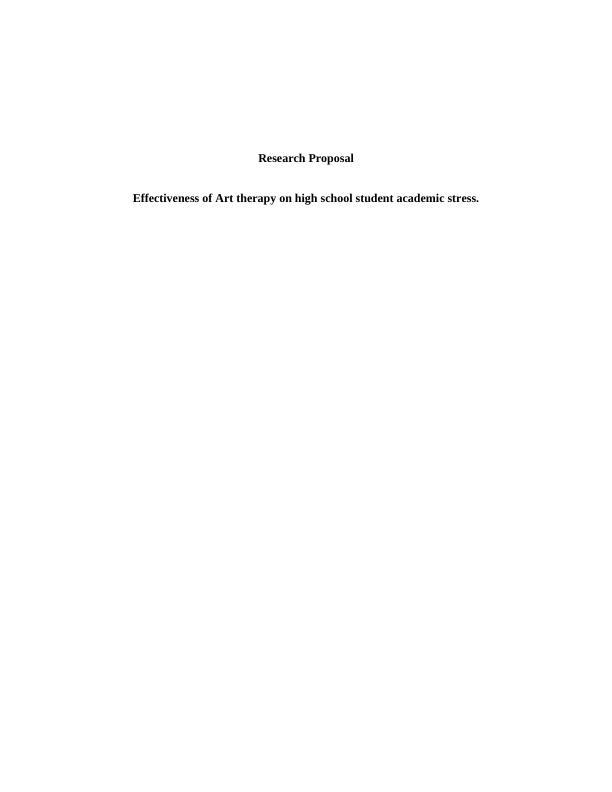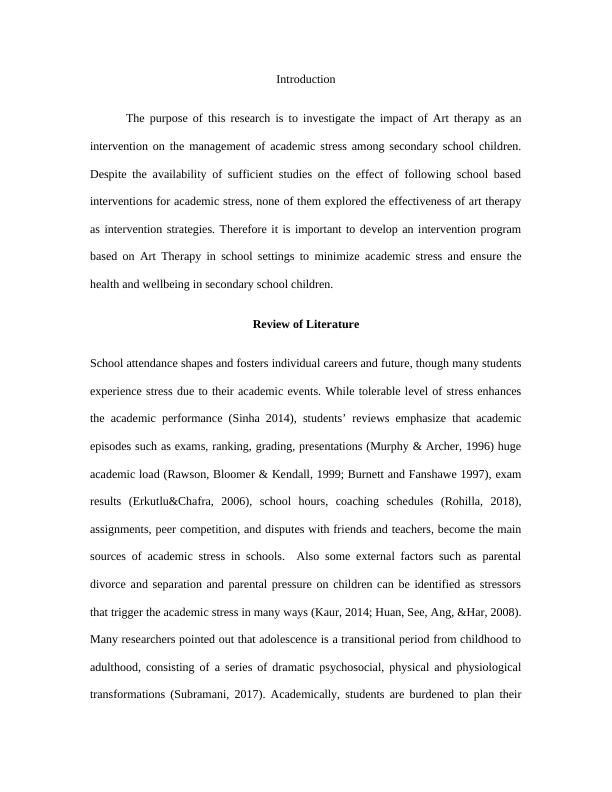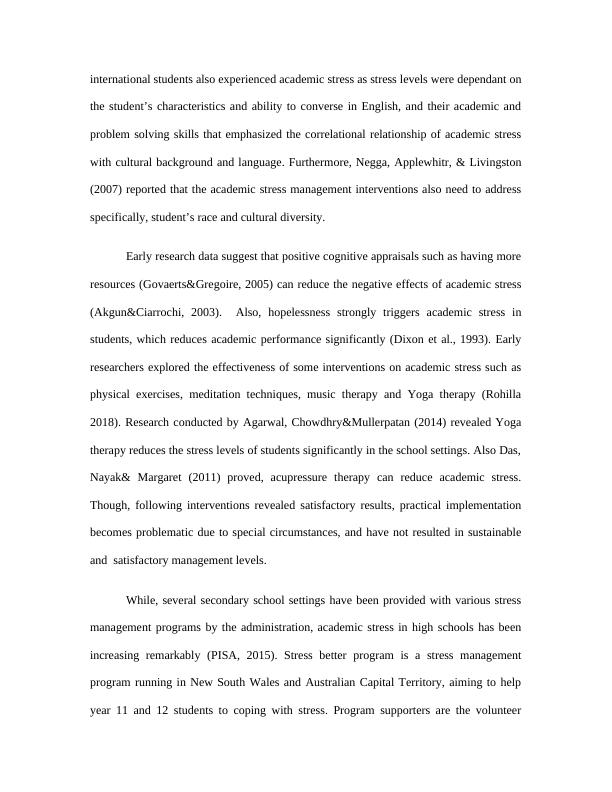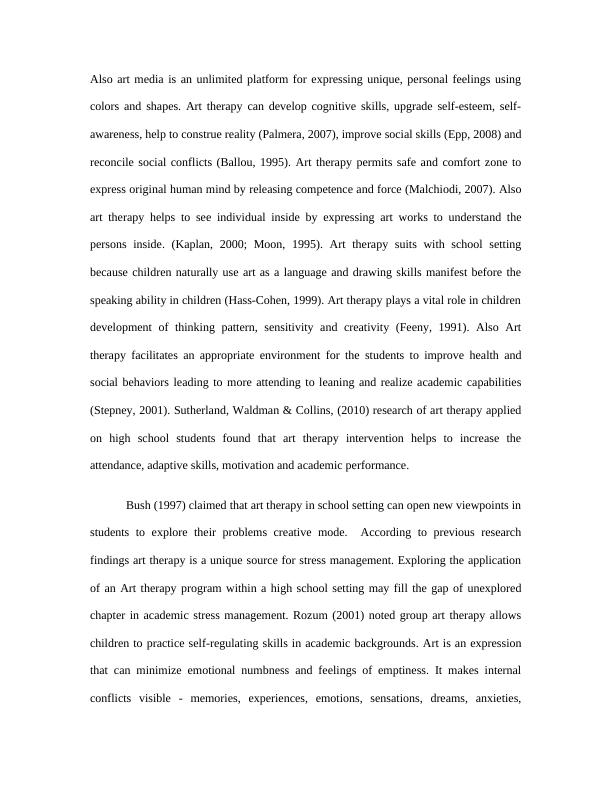Effectiveness of Art Therapy on High School Student Academic Stress
24 Pages5836 Words393 Views
Added on 2023-04-21
About This Document
This research aims to investigate the effectiveness of Art therapy as an intervention for reducing academic stress levels in secondary school children. The study will explore the impact of Art therapy on academic performance, stress reduction, emotional expression, and enjoyment of school subjects. The proposed program, called 'Colors of Life', will be a 12-week school-wide stress prevention program delivered to Year 11 and 12 students. The effectiveness of the program will be evaluated through surveys and interviews.
Effectiveness of Art Therapy on High School Student Academic Stress
Added on 2023-04-21
ShareRelated Documents
Research Proposal
Effectiveness of Art therapy on high school student academic stress.
Effectiveness of Art therapy on high school student academic stress.

Introduction
The purpose of this research is to investigate the impact of Art therapy as an
intervention on the management of academic stress among secondary school children.
Despite the availability of sufficient studies on the effect of following school based
interventions for academic stress, none of them explored the effectiveness of art therapy
as intervention strategies. Therefore it is important to develop an intervention program
based on Art Therapy in school settings to minimize academic stress and ensure the
health and wellbeing in secondary school children.
Review of Literature
School attendance shapes and fosters individual careers and future, though many students
experience stress due to their academic events. While tolerable level of stress enhances
the academic performance (Sinha 2014), students’ reviews emphasize that academic
episodes such as exams, ranking, grading, presentations (Murphy & Archer, 1996) huge
academic load (Rawson, Bloomer & Kendall, 1999; Burnett and Fanshawe 1997), exam
results (Erkutlu&Chafra, 2006), school hours, coaching schedules (Rohilla, 2018),
assignments, peer competition, and disputes with friends and teachers, become the main
sources of academic stress in schools. Also some external factors such as parental
divorce and separation and parental pressure on children can be identified as stressors
that trigger the academic stress in many ways (Kaur, 2014; Huan, See, Ang, &Har, 2008).
Many researchers pointed out that adolescence is a transitional period from childhood to
adulthood, consisting of a series of dramatic psychosocial, physical and physiological
transformations (Subramani, 2017). Academically, students are burdened to plan their
The purpose of this research is to investigate the impact of Art therapy as an
intervention on the management of academic stress among secondary school children.
Despite the availability of sufficient studies on the effect of following school based
interventions for academic stress, none of them explored the effectiveness of art therapy
as intervention strategies. Therefore it is important to develop an intervention program
based on Art Therapy in school settings to minimize academic stress and ensure the
health and wellbeing in secondary school children.
Review of Literature
School attendance shapes and fosters individual careers and future, though many students
experience stress due to their academic events. While tolerable level of stress enhances
the academic performance (Sinha 2014), students’ reviews emphasize that academic
episodes such as exams, ranking, grading, presentations (Murphy & Archer, 1996) huge
academic load (Rawson, Bloomer & Kendall, 1999; Burnett and Fanshawe 1997), exam
results (Erkutlu&Chafra, 2006), school hours, coaching schedules (Rohilla, 2018),
assignments, peer competition, and disputes with friends and teachers, become the main
sources of academic stress in schools. Also some external factors such as parental
divorce and separation and parental pressure on children can be identified as stressors
that trigger the academic stress in many ways (Kaur, 2014; Huan, See, Ang, &Har, 2008).
Many researchers pointed out that adolescence is a transitional period from childhood to
adulthood, consisting of a series of dramatic psychosocial, physical and physiological
transformations (Subramani, 2017). Academically, students are burdened to plan their

choices and decisions for senior high schools before they enter real world. Fear of failure,
increment in academic standards, large school size, bigger social circle, decisions to
pursue a career, learning and attention, are the most stressful events that senior high
school children experience in their academic life. However, these stressors lead to a
decrease in academic performance, which may potentially lead to substance abuse such
as alcohol, cannabis use and smoking, including a high risk of suicide and bullying
behaviors (Ang and Huan 2006b; Ma 2001; McCormack 1996; Weidner et al. 1996),
dropouts (Sutherland, Waldman & Collins, 2010) and crime offenders (Jones, 1993).
Stress related psychological and behavioral negative effects might cause high blood
pressure, asthma, stomach ulcers (Aheneku et al., 2000; Bossy, 2000) and common cold
(Selve, 1975). Also, stress induces psychological complications such as schizophrenia,
suicidal feelings ( Dixen et al.,1991), social phobia, aggressiveness, anger issues,
shyness, anxiety, lack of interest, depression and sleeping disorders. Previous empirical
researches have linked academic stress with poor health (Greenberg, 1981; Lesko&
Summerfield, 1989), decrease in academic performance and lower course grades (Clark
&Rieker, 1986; Linn &Zeppa, 1984; Struthers, Perry &Menec, 2000). Also chronic stress
leads to early brain development obstructions, nervous and immune system coordination
disorders, and some late life stress relate diseases such as cancer, depression and eating
disorders (Middlebrooks &Audage, 2008). Severity of the causes of academic stress may
depend on individual factors, age, physical fitness, genetics, personality and childhood
experience (Kalat, 2013). Also, intensity of the stressors is proportional to the magnitude
of the dangerous behaviors (Panchanath&Shanmugaganiesan, 1992) resulting from
autonomic nervous system activation by stress. A recent experiment revealed that
increment in academic standards, large school size, bigger social circle, decisions to
pursue a career, learning and attention, are the most stressful events that senior high
school children experience in their academic life. However, these stressors lead to a
decrease in academic performance, which may potentially lead to substance abuse such
as alcohol, cannabis use and smoking, including a high risk of suicide and bullying
behaviors (Ang and Huan 2006b; Ma 2001; McCormack 1996; Weidner et al. 1996),
dropouts (Sutherland, Waldman & Collins, 2010) and crime offenders (Jones, 1993).
Stress related psychological and behavioral negative effects might cause high blood
pressure, asthma, stomach ulcers (Aheneku et al., 2000; Bossy, 2000) and common cold
(Selve, 1975). Also, stress induces psychological complications such as schizophrenia,
suicidal feelings ( Dixen et al.,1991), social phobia, aggressiveness, anger issues,
shyness, anxiety, lack of interest, depression and sleeping disorders. Previous empirical
researches have linked academic stress with poor health (Greenberg, 1981; Lesko&
Summerfield, 1989), decrease in academic performance and lower course grades (Clark
&Rieker, 1986; Linn &Zeppa, 1984; Struthers, Perry &Menec, 2000). Also chronic stress
leads to early brain development obstructions, nervous and immune system coordination
disorders, and some late life stress relate diseases such as cancer, depression and eating
disorders (Middlebrooks &Audage, 2008). Severity of the causes of academic stress may
depend on individual factors, age, physical fitness, genetics, personality and childhood
experience (Kalat, 2013). Also, intensity of the stressors is proportional to the magnitude
of the dangerous behaviors (Panchanath&Shanmugaganiesan, 1992) resulting from
autonomic nervous system activation by stress. A recent experiment revealed that

international students also experienced academic stress as stress levels were dependant on
the student’s characteristics and ability to converse in English, and their academic and
problem solving skills that emphasized the correlational relationship of academic stress
with cultural background and language. Furthermore, Negga, Applewhitr, & Livingston
(2007) reported that the academic stress management interventions also need to address
specifically, student’s race and cultural diversity.
Early research data suggest that positive cognitive appraisals such as having more
resources (Govaerts&Gregoire, 2005) can reduce the negative effects of academic stress
(Akgun&Ciarrochi, 2003). Also, hopelessness strongly triggers academic stress in
students, which reduces academic performance significantly (Dixon et al., 1993). Early
researchers explored the effectiveness of some interventions on academic stress such as
physical exercises, meditation techniques, music therapy and Yoga therapy (Rohilla
2018). Research conducted by Agarwal, Chowdhry&Mullerpatan (2014) revealed Yoga
therapy reduces the stress levels of students significantly in the school settings. Also Das,
Nayak& Margaret (2011) proved, acupressure therapy can reduce academic stress.
Though, following interventions revealed satisfactory results, practical implementation
becomes problematic due to special circumstances, and have not resulted in sustainable
and satisfactory management levels.
While, several secondary school settings have been provided with various stress
management programs by the administration, academic stress in high schools has been
increasing remarkably (PISA, 2015). Stress better program is a stress management
program running in New South Wales and Australian Capital Territory, aiming to help
year 11 and 12 students to coping with stress. Program supporters are the volunteer
the student’s characteristics and ability to converse in English, and their academic and
problem solving skills that emphasized the correlational relationship of academic stress
with cultural background and language. Furthermore, Negga, Applewhitr, & Livingston
(2007) reported that the academic stress management interventions also need to address
specifically, student’s race and cultural diversity.
Early research data suggest that positive cognitive appraisals such as having more
resources (Govaerts&Gregoire, 2005) can reduce the negative effects of academic stress
(Akgun&Ciarrochi, 2003). Also, hopelessness strongly triggers academic stress in
students, which reduces academic performance significantly (Dixon et al., 1993). Early
researchers explored the effectiveness of some interventions on academic stress such as
physical exercises, meditation techniques, music therapy and Yoga therapy (Rohilla
2018). Research conducted by Agarwal, Chowdhry&Mullerpatan (2014) revealed Yoga
therapy reduces the stress levels of students significantly in the school settings. Also Das,
Nayak& Margaret (2011) proved, acupressure therapy can reduce academic stress.
Though, following interventions revealed satisfactory results, practical implementation
becomes problematic due to special circumstances, and have not resulted in sustainable
and satisfactory management levels.
While, several secondary school settings have been provided with various stress
management programs by the administration, academic stress in high schools has been
increasing remarkably (PISA, 2015). Stress better program is a stress management
program running in New South Wales and Australian Capital Territory, aiming to help
year 11 and 12 students to coping with stress. Program supporters are the volunteer

educators, who help manage bottled up feelings of the students by sharing their own
stories and giving an academic support (Kesteven& Allen 2017). Headspace program is
another stress management program, implemented by the Victoria educational
department as a resource program, to support students to reduce stress in exam conditions
by encouraging students to engage with sports, enjoyable activities, exercise and advise
to get nutritious foods. Also Beyond Blue organization has designed several programs to
help to reduce stress in schools such as “the desk” and secondary schools program year 8-
10. Although, schools conducting many stress management programs, academic stress is
increasing alarmingly highlighting the requirement of particular stress management
strategy for the secondary schools.
Art is nonverbal media, allowing individuals to smoothly and safely express their
range of emotions and feelings within an integrated platform. Also art allows participants
to utilize art media in free minds without any limitations and simultaneously expressions
which help to breakthrough mental blockades. Also, historical cave art emphasizes that
art was the primarily used communication and self-expressed method of humans since the
dawn of the human civilization (Rubin, 1978). Humans tend to express daily hassle
related fears and frustrations in comfort zones. Art is a powerful medicine that can heal
deepest fears and pains by stimulating meditation mind set (Logman, 1990). Art therapy
is a psychoeducational therapeutic strategy that art media allows to express through
communication of individual feelings, thoughts and emotions (Shostak, 1985). In general
human verbal expressions are not completely contained as pure thoughts due to some
interpersonal defenses and limitations of language (Albert-Puleo& Osha, 1976). Art
therapy allows individuals to open up and avoid defenses by establishing a free mind.
stories and giving an academic support (Kesteven& Allen 2017). Headspace program is
another stress management program, implemented by the Victoria educational
department as a resource program, to support students to reduce stress in exam conditions
by encouraging students to engage with sports, enjoyable activities, exercise and advise
to get nutritious foods. Also Beyond Blue organization has designed several programs to
help to reduce stress in schools such as “the desk” and secondary schools program year 8-
10. Although, schools conducting many stress management programs, academic stress is
increasing alarmingly highlighting the requirement of particular stress management
strategy for the secondary schools.
Art is nonverbal media, allowing individuals to smoothly and safely express their
range of emotions and feelings within an integrated platform. Also art allows participants
to utilize art media in free minds without any limitations and simultaneously expressions
which help to breakthrough mental blockades. Also, historical cave art emphasizes that
art was the primarily used communication and self-expressed method of humans since the
dawn of the human civilization (Rubin, 1978). Humans tend to express daily hassle
related fears and frustrations in comfort zones. Art is a powerful medicine that can heal
deepest fears and pains by stimulating meditation mind set (Logman, 1990). Art therapy
is a psychoeducational therapeutic strategy that art media allows to express through
communication of individual feelings, thoughts and emotions (Shostak, 1985). In general
human verbal expressions are not completely contained as pure thoughts due to some
interpersonal defenses and limitations of language (Albert-Puleo& Osha, 1976). Art
therapy allows individuals to open up and avoid defenses by establishing a free mind.

Also art media is an unlimited platform for expressing unique, personal feelings using
colors and shapes. Art therapy can develop cognitive skills, upgrade self-esteem, self-
awareness, help to construe reality (Palmera, 2007), improve social skills (Epp, 2008) and
reconcile social conflicts (Ballou, 1995). Art therapy permits safe and comfort zone to
express original human mind by releasing competence and force (Malchiodi, 2007). Also
art therapy helps to see individual inside by expressing art works to understand the
persons inside. (Kaplan, 2000; Moon, 1995). Art therapy suits with school setting
because children naturally use art as a language and drawing skills manifest before the
speaking ability in children (Hass-Cohen, 1999). Art therapy plays a vital role in children
development of thinking pattern, sensitivity and creativity (Feeny, 1991). Also Art
therapy facilitates an appropriate environment for the students to improve health and
social behaviors leading to more attending to leaning and realize academic capabilities
(Stepney, 2001). Sutherland, Waldman & Collins, (2010) research of art therapy applied
on high school students found that art therapy intervention helps to increase the
attendance, adaptive skills, motivation and academic performance.
Bush (1997) claimed that art therapy in school setting can open new viewpoints in
students to explore their problems creative mode. According to previous research
findings art therapy is a unique source for stress management. Exploring the application
of an Art therapy program within a high school setting may fill the gap of unexplored
chapter in academic stress management. Rozum (2001) noted group art therapy allows
children to practice self-regulating skills in academic backgrounds. Art is an expression
that can minimize emotional numbness and feelings of emptiness. It makes internal
conflicts visible - memories, experiences, emotions, sensations, dreams, anxieties,
colors and shapes. Art therapy can develop cognitive skills, upgrade self-esteem, self-
awareness, help to construe reality (Palmera, 2007), improve social skills (Epp, 2008) and
reconcile social conflicts (Ballou, 1995). Art therapy permits safe and comfort zone to
express original human mind by releasing competence and force (Malchiodi, 2007). Also
art therapy helps to see individual inside by expressing art works to understand the
persons inside. (Kaplan, 2000; Moon, 1995). Art therapy suits with school setting
because children naturally use art as a language and drawing skills manifest before the
speaking ability in children (Hass-Cohen, 1999). Art therapy plays a vital role in children
development of thinking pattern, sensitivity and creativity (Feeny, 1991). Also Art
therapy facilitates an appropriate environment for the students to improve health and
social behaviors leading to more attending to leaning and realize academic capabilities
(Stepney, 2001). Sutherland, Waldman & Collins, (2010) research of art therapy applied
on high school students found that art therapy intervention helps to increase the
attendance, adaptive skills, motivation and academic performance.
Bush (1997) claimed that art therapy in school setting can open new viewpoints in
students to explore their problems creative mode. According to previous research
findings art therapy is a unique source for stress management. Exploring the application
of an Art therapy program within a high school setting may fill the gap of unexplored
chapter in academic stress management. Rozum (2001) noted group art therapy allows
children to practice self-regulating skills in academic backgrounds. Art is an expression
that can minimize emotional numbness and feelings of emptiness. It makes internal
conflicts visible - memories, experiences, emotions, sensations, dreams, anxieties,

End of preview
Want to access all the pages? Upload your documents or become a member.
Related Documents
Anxiety Affiliation in Adolescent and Children in Facultylg...
|22
|4642
|341
Document on Sample Resumelg...
|5
|621
|60
Mental Health and Well-being Among Young Australianslg...
|20
|3869
|478
